Chatbot Market Size
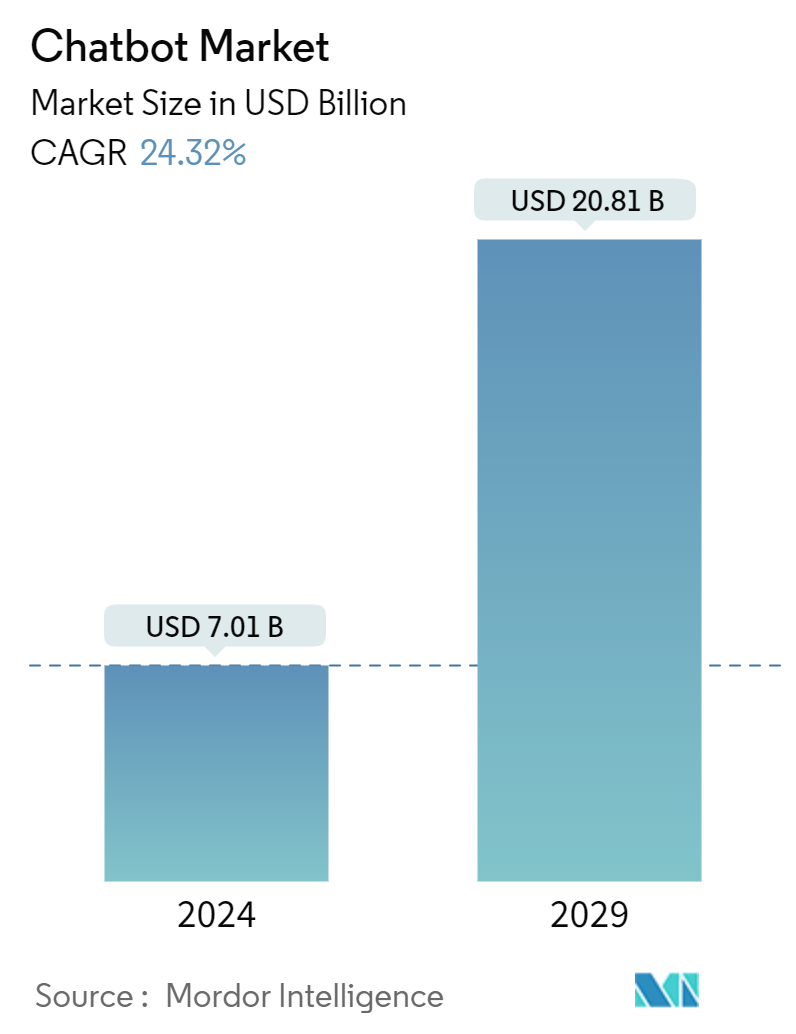
| Study Period | 2019 - 2029 |
| Market Size (2024) | USD 7.01 Billion |
| Market Size (2029) | USD 20.81 Billion |
| CAGR (2024 - 2029) | 24.32 % |
| Fastest Growing Market | Asia Pacific |
| Largest Market | North America |
Major Players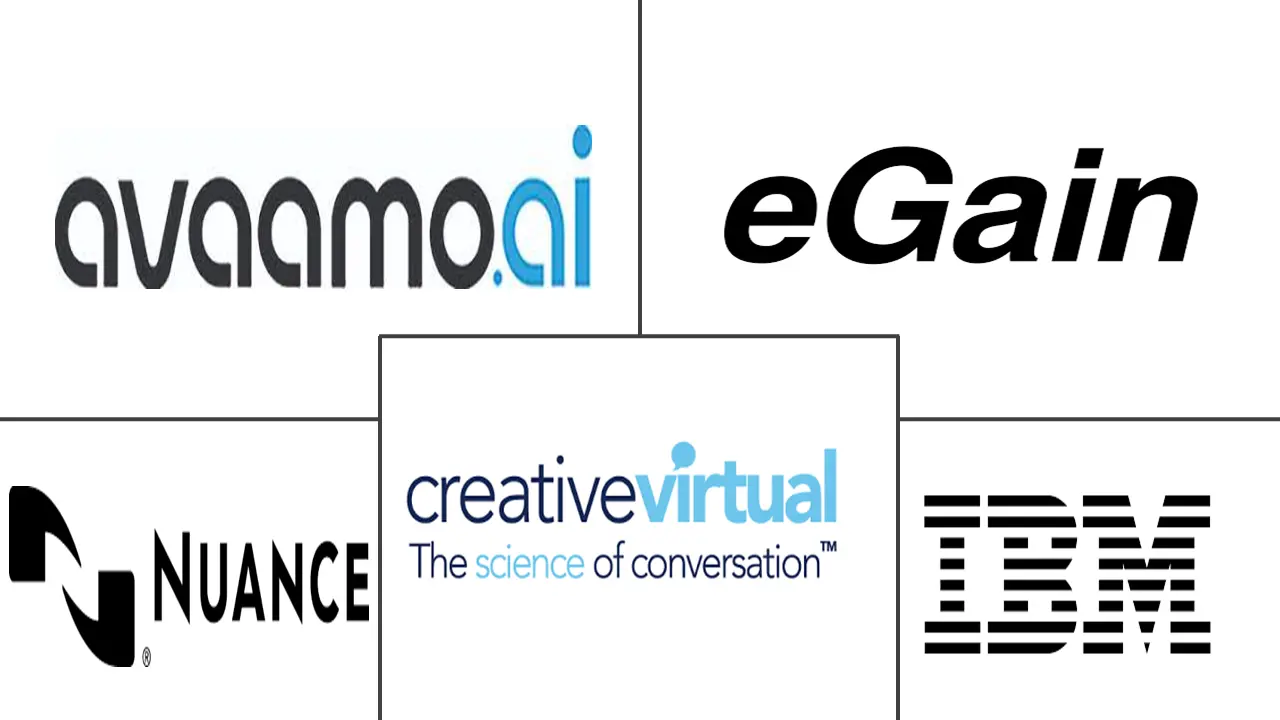
*Disclaimer: Major Players sorted in no particular order |
Chatbot Market Analysis
The Chatbot Market size is estimated at USD 7.01 billion in 2024, and is expected to reach USD 20.81 billion by 2029, growing at a CAGR of 24.32% during the forecast period (2024-2029).
AI-Powered Chatbots Revolutionizing Customer Engagement in the Digital Era
The global chatbot market is experiencing unprecedented growth, driven by the digital transformation wave sweeping across industries. As businesses increasingly prioritize customer-centric approaches, chatbots have emerged as a critical tool for enhancing customer engagement and streamlining operations. The integration of artificial intelligence (AI) and natural language processing (NLP) technologies has significantly improved chatbots' capabilities, enabling them to understand context, sentiment, and complex queries, thereby delivering more personalized and efficient customer experiences.
Chatbot Market Trends
Chatbot Revolution: Messenger Apps Fuel Global Market Growth
The Global Chatbot Market growth is driven by the rising dominance of messenger applications. With WhatsApp boasting 2 billion active monthly users, WeChat following at 1.263 billion, and Facebook Messenger at 998 million as of January 2022, these platforms provide an ideal ecosystem for chatbot integration. This trend is revolutionizing customer engagement, allowing brands to interact personally with users at scale on platforms where they already spend significant time. The integration of AI-powered chatbots with these messaging apps enables businesses to handle routine inquiries efficiently, share product information, and assist customers throughout their discovery process, ultimately enhancing the overall customer experience.
The adoption of chatbot applications in industries has been accelerated by major tech players entering the market. Facebook's launch of a developer platform and Google's introduction of Google Assistant have spurred the creation of numerous chatbot applications across various channels. This proliferation is not limited to customer support; AI enabled chatbots are now being deployed for product discovery, personalized recommendations, and even facilitating purchases directly within messaging platforms. The convenience and familiarity of these applications for users, combined with the ability to save chat history for future personalization, make chatbots an increasingly attractive solution for businesses seeking to improve customer engagement and streamline operations.
AI-Driven Analytics: Powering Chatbot Market Expansion
The increasing demand for consumer analytics is another significant driver propelling the Global Chatbot Market forward. Organizations are becoming increasingly customer-centric, focusing on leveraging data from various sources to gain a 360-degree view of their customers. According to Forbes, approximately 78% of enterprise companies plan to implement various customer analytical tools, highlighting the growing importance of data-driven decision-making. Chatbot usage statistics play a crucial role in this trend by generating large amounts of customer data, which, when integrated with natural language processing analytics programs, can provide valuable insights into customer behavior, preferences, and pain points.
The implementation of chatbot services enables businesses to analyze customer interactions in real-time, leading to improved products, user experiences, and more effective sales and marketing strategies. Active rate, engaged rate, confusion rate, and conversion steps are just a few of the metrics that companies can track through chatbot interactions. Moreover, the integration of sentiment analysis capabilities allows businesses to gauge customer feelings without relying on traditional surveys, providing a more nuanced understanding of customer satisfaction. This wealth of market data and analytics empowers companies to make data-driven decisions, personalize customer experiences, and ultimately drive business growth in the competitive chatbot market landscape.
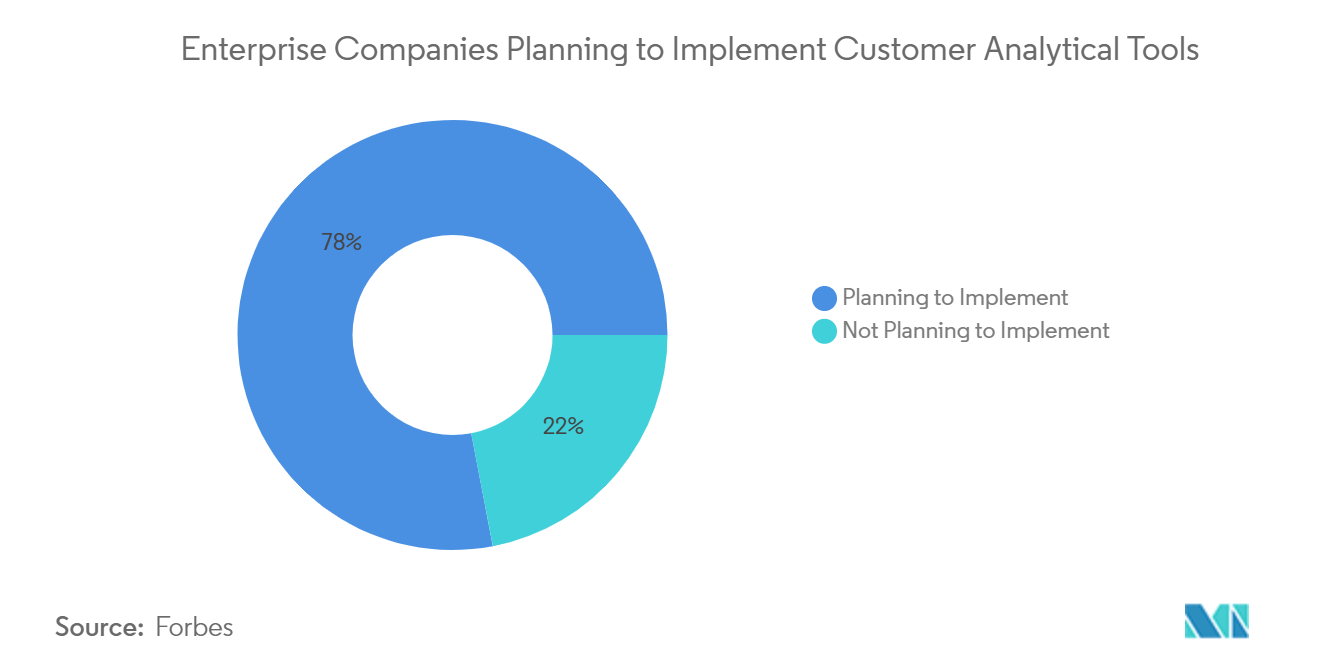
Chatbot Market End-User Segment Analysis
BFSI Chatbot Market Analysis:
The Banking, Financial Services, and Insurance (BFSI) sector is a significant adopter of chatbot technology, commanding a 23.00% market share in 2024. Chatbots in this sector primarily enhance customer experience by providing services such as lead generation, customer acquisition, smart payment processing, and automated customer support. The BFSI sector leverages AI chatbot applications to automate repetitive inquiries, streamline online support operations, and provide personalized banking services.
Key drivers for chatbot adoption in industries like BFSI include the need for 24/7 customer service, the ability to handle high volumes of inquiries simultaneously, and the potential for cost reduction in customer service operations. Chatbots in this sector are becoming increasingly sophisticated, using natural language processing and machine learning to provide more human-like interactions and personalized financial advice.
Recent trends show a growing interest in integrating chatbots available in market with popular messaging platforms like WhatsApp and Facebook Messenger, allowing banks to meet customers where they are most comfortable. For instance, Bank of America's AI-powered chatbot, Erica, passed the one billion client interactions mark in October 2022, helping nearly 32 million clients since its launch in 2018. This demonstrates the massive scale and chatbot adoption in industries such as BFSI.
Healthcare Chatbot Market Analysis:
The healthcare sector has seen a significant uptake in chatbot technology, with an impressive growth rate of 33.72% between 2024 and 2028. This rapid growth has been particularly accelerated by the global COVID-19 pandemic. Chatbot applications in healthcare are primarily used for scheduling appointments, collecting patient data, symptom assessment, and providing quick responses to common medical queries.
One of the fastest-growing applications of chatbots in healthcare is in mental health support. AI-powered chatbots are being developed to provide cognitive behavioral therapy (CBT) for patients with depression, PTSD, and anxiety. These AI enabled chatbots can interact via text, audio, and even video, offering a scalable solution to address the growing demand for mental health services.
An example of innovation in this space is the Northwell Health Pregnancy Chats, an AI-driven pregnancy chatbot launched in January 2023. This customized, conversational platform is a vital tool in Northwell's high-touch and high-tech campaign to reduce maternal morbidity and mortality, showcasing how chatbots can address critical healthcare needs beyond basic patient inquiries.
IT and Telecommunication Chatbot Market Analysis:
In the IT and Telecommunication sector, chatbot companies are revolutionizing customer service and operational efficiency. Chatbot services are primarily used for managing inquiries, handling technical support, and providing information about services and billing.
A key trend in this sector is the use of AI-powered chatbots to detect and prevent fraud. These advanced AI enabled chatbot solutions can monitor network traffic, recognize warning signs of irregular behavior, and issue alerts to customers or the company, enhancing security measures.
For example, in July 2022, Infobip implemented its chatbot development platform at Africell, a mobile telco operator group in Africa. This implementation enabled Africell to communicate more efficiently with its subscribers and implement the latest trends in customer communications, demonstrating the practical application of chatbot technology advancements in improving telecom operations.
Retail Chatbot Market Analysis:
The retail sector is at the forefront of chatbot adoption, using this technology to transform the shopping experience both online and in-store. Retail chatbots are primarily used for lead generation, supporting in-store purchases, sending mobile alerts and updates, and providing instant customer service.
A significant trend in chatbot market segmentation is the integration of recommendation algorithms. These AI-powered chatbots can analyze customer preferences, browsing history, and purchase patterns to offer personalized product recommendations, potentially boosting sales and customer satisfaction.
A notable case study is ZALORA, which implemented a multifunctional AI messenger bot to streamline their online support operations and marketing. The impact was significant, with over 2.4 million new users served over a year and more than 4 million conversation sessions powered, showcasing the scalability and efficiency of chatbot deployment strategies in retail customer service.
Travel and Hospitality Chatbot Market Analysis:
The travel and hospitality industry has embraced chatbot services to enhance customer service and streamline operations. Hospitality chatbots are primarily used for managing inquiries, handling reservations, cross-selling services, and addressing luggage-related questions.
A key trend in this sector is the use of chatbot applications for personalized travel recommendations. By analyzing a user's travel history and preferences, AI-enabled chatbots can offer tailored suggestions for destinations, accommodations, and activities, enhancing the overall travel experience.
For instance, in March 2022, Kerala Tourism launched a 24x7 WhatsApp chatbot named 'Maya' to provide tourists with information and updates on the tourism ecosystem in the state. This implementation demonstrates how AI messenger bots can offer round-the-clock assistance and personalized information to travelers, improving their experience and potentially increasing tourism engagement.
Other End-User Verticals Chatbot Market Analysis:
This segment encompasses various industries including logistics and transportation, media and entertainment, and government sectors. In logistics, AI-enabled chatbots are increasingly used for delivery booking, shipment tracking, and fleet management.
A notable trend in the government sector is the use of AI chatbot applications to improve public service delivery. For example, in February 2023, the Odisha government in India launched the Ama KrushAI chatbot, dedicated to the agro sector. This AI-enabled chatbot offers farmers information on agronomic practices, government schemes, and loan products from more than 40 cooperative and commercial banks, showcasing how chatbots available in market can be used to disseminate critical information in specialized sectors.
In the media and entertainment industry, chatbot development platforms are being utilized to deliver personalized content recommendations, enhance audience engagement, and provide interactive entertainment experiences. This sector is exploring innovative ways to use AI messenger bots for content distribution and audience interaction, potentially reshaping how media is consumed and experienced.
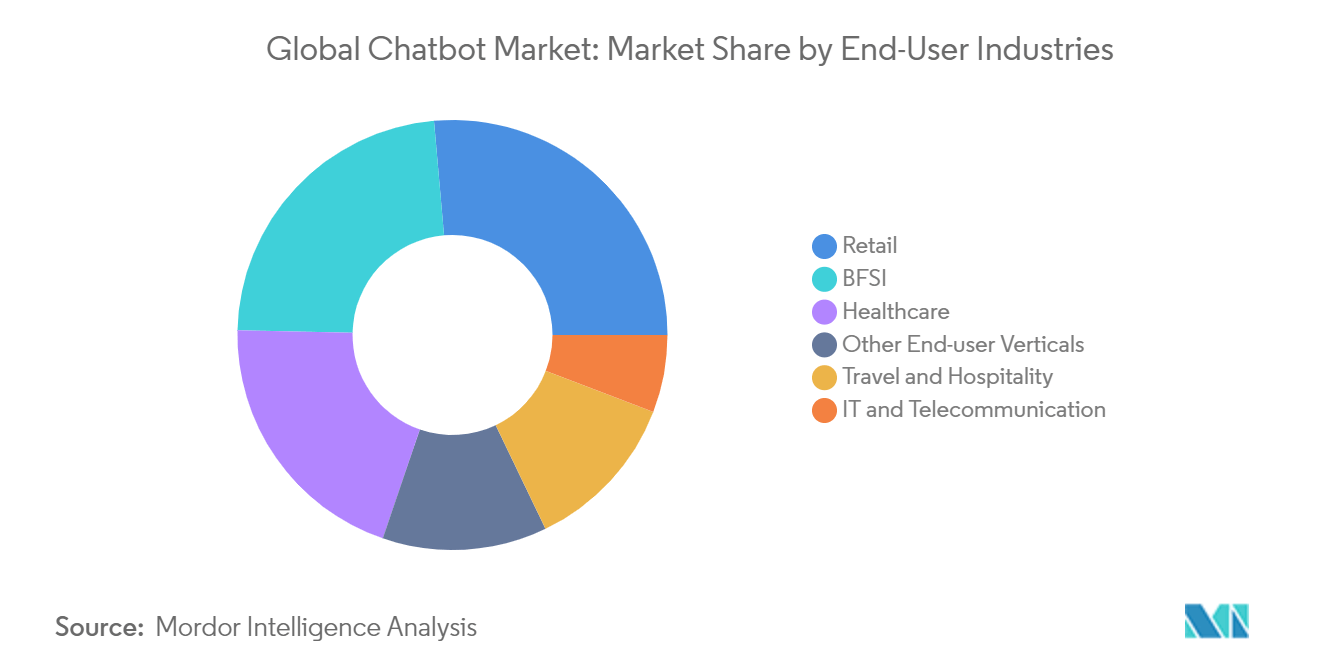
Chatbot Market Geography Segment Analysis
North America Chatbot Market Analysis:
The North American chatbot market is at the forefront of innovation, with significant investments in healthcare and financial chatbots. The region is driving towards AI-powered and voice recognition chatbot technologies, with vendors focusing on enhancing customer service experiences. The COVID-19 pandemic has accelerated chatbot adoption across various sectors, including healthcare, BFSI, e-commerce, telecommunication, and retail. The market is witnessing a surge in demand for intelligent conversational AI tools, with companies like Zoom planning to launch AI-enabled chatbots for improved customer interactions.
United States Chatbot Market Analysis:
The United States is a key player in the North American chatbot market, with companies like NIPSCO implementing chatbot services and live chat technologies to enhance customer experiences. The media and entertainment industry is increasingly leveraging chatbot development tools to improve content discovery and access. For instance, Narcity Media Group launched Narcity Chat, a ChatGPT-powered search and chatbot function, demonstrating the growing trend of AI-driven personalized user experiences in the content industry. The US chatbot market size in 2024 is projected to reach USD 2,158.7 million.
Europe Chatbot Market Analysis:
The Europe Chatbot Market is characterized by its diverse end-user industries, including BFSI, travel, public sector, healthcare, and automotive. These sectors are increasingly adopting chatbots for more efficient self-service solutions. The region is home to numerous chatbot companies, particularly in the United Kingdom, offering AI-enabled chatbot market solutions for financial advice, savings assistance, customer service applications, and industrial manufacturing environments. European companies are actively expanding their chatbot services to provide 24/7 customer support across multiple locations.
United Kingdom Chatbot Market Analysis:
The United Kingdom is a hotbed for chatbot innovation, with over 313 chatbot startups specializing in various sectors. Professional services firms in the UK, such as PricewaterhouseCoopers LLP (PwC), are leveraging AI-powered chatbots to boost productivity in legal services. The integration of chatbots in professional services demonstrates the technology's potential to streamline complex tasks and improve efficiency across industries. The UK chatbot market size in 2024 is estimated to be USD 1,583.5 million.
Germany Chatbot Market Analysis:
Germany is experiencing significant growth in chatbot applications across various end-user verticals, particularly in BFSI and retail sectors. German companies are leveraging AI chatbot applications to offer innovative and personalized customer experiences. For example, the REWE Group launched a Savings Assistant chatbot on Instagram to inform shoppers about weekly offers, showcasing the integration of chatbots with social media platforms for enhanced customer engagement. The German chatbot market is projected to grow at a CAGR of 28.06% between 2024 and 2028.
Asia Pacific Chatbot Market Analysis:
The Asia Pacific Chatbot Market is witnessing rapid growth, driven by the increasing need to enhance customer experiences across various sectors. The region is experiencing a significant rise in messaging service usage, which is expected to surpass social networking sites in terms of user numbers. Advancements in natural language processing are simplifying interactions between computers and human languages, further fueling market growth. Government initiatives and the emergence of chatbot startups are contributing to the region's dynamic chatbot ecosystem.
Japan Chatbot Market Analysis:
Japan, known for its technological advancements, is embracing AI chatbot applications across various industries. The country's focus on improving customer service and efficiency is driving the adoption of AI chatbot market solutions. Japanese companies are leveraging chatbots to provide personalized experiences and streamline operations in sectors such as retail, banking, and healthcare. The Japanese chatbot market is expected to grow at a CAGR of 32.90% between 2024 and 2028.
China Chatbot Market Analysis:
China's chatbot market is experiencing rapid growth, fueled by the country's large digital-savvy population and the increasing adoption of AI technologies. Chinese tech giants and startups are developing sophisticated AI-powered chatbots that cater to various industries, including e-commerce, finance, and customer service. The integration of chatbots with popular messaging platforms like WeChat is driving widespread adoption and enhancing customer engagement across sectors.
India Chatbot Market Analysis:
India is emerging as a significant player in the Asia Pacific Chatbot Market. The country is witnessing increased adoption of chatbots across various sectors, including government services, agriculture, and finance. For instance, the Odisha government launched the Ama KrushAI chatbot to provide farmers with information on agronomic practices and government schemes. This initiative demonstrates the potential of AI-enabled chatbots in improving public services and supporting key economic sectors in developing economies.
Latin America Chatbot Market Analysis:
The Latin America Chatbot Market is experiencing significant growth, driven by increasing digitization and the application of artificial intelligence in countries like Brazil, Mexico, and Argentina. The region is witnessing a surge in new chatbot product launches and growing acceptance of customer service automation among end-user businesses aiming to reduce operational costs. Market vendors like Sbyven are developing sophisticated AI-powered chatbots using state-of-the-art technology, particularly for the BFSI sector, demonstrating the region's focus on enhancing customer support and automating banking transactions.
Brazil Chatbot Market Analysis:
Brazil is emerging as a key player in the Latin America Chatbot Market. The country's large and increasingly digital population is driving the adoption of AI-enabled chatbots across various sectors, including e-commerce, banking, and customer service. Brazilian companies are leveraging AI-powered chatbots to improve customer engagement and streamline operations. The integration of chatbots with popular messaging platforms like WhatsApp is particularly notable in Brazil, reflecting the country's preference for mobile-first solutions. The Brazilian chatbot market is projected to grow at a CAGR of 28.78% between 2024 and 2028.
Middle East & Africa Chatbot Market Analysis:
The Middle East and Africa Chatbot Market is witnessing significant growth, driven by the booming hospitality, tourism, and telecommunications sectors. GCC nations are exploring economic transformation plans that include AI and ML technologies, creating a fertile ground for chatbot adoption. The region is seeing increased implementation of AI chatbot applications in the BFSI and logistics industries, with global tech companies and local startups partnering to develop advanced AI technologies.
Saudi Arabia Chatbot Market Analysis:
Saudi Arabia is emerging as a key player in the Middle East's chatbot market, aligning with the country's Vision 2030 plan to diversify its economy and embrace digital technologies. The kingdom is witnessing increased adoption of AI-enabled chatbots in sectors such as banking, retail, and government services. Saudi companies are leveraging chatbots to enhance customer experiences and streamline operations. The Saudi Arabian chatbot market is expected to grow at a CAGR of 25.12% between 2024 and 2028.
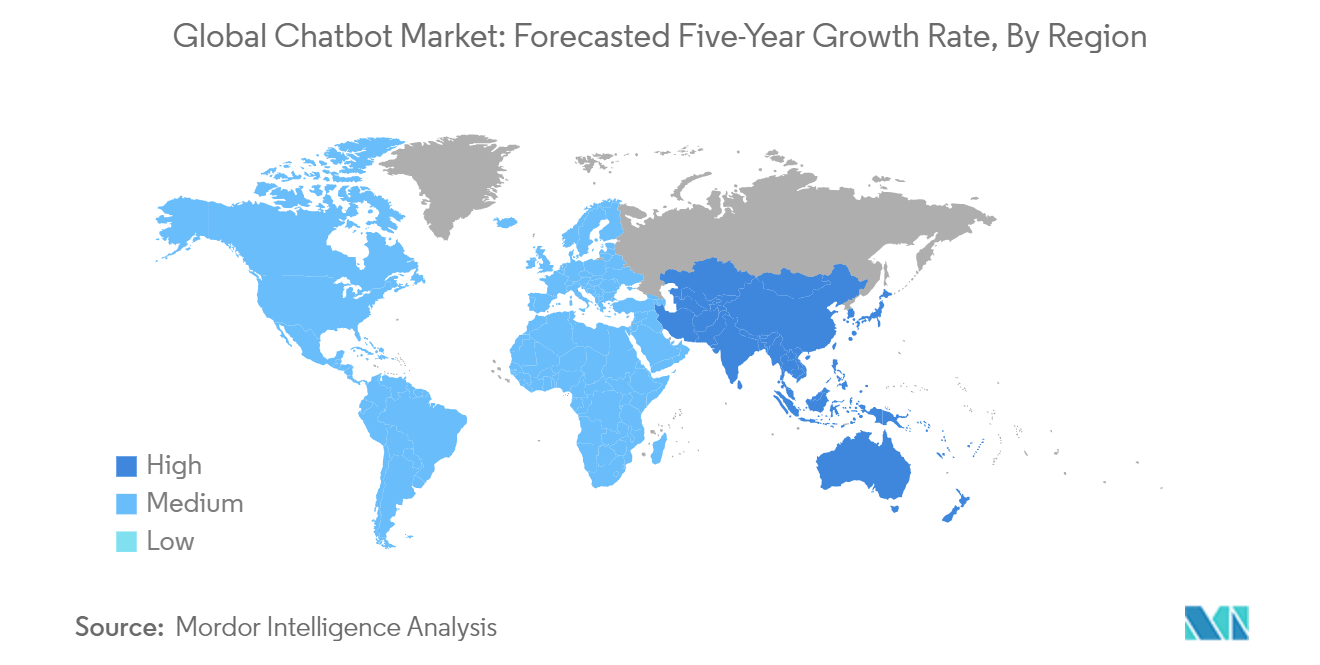
Chatbot Industry Overview
Top Companies in the Chatbot Market:
- IBM Corporation
- Nuance Communications Inc. (Microsoft Corporation)
- Amazon Web Services (AWS)
- Google (Dialogflow)
- [24]7.ai Inc.
- LiveChat Inc.
- Artificial Solutions International AB
- eGain Corporation
- Kore.ai Inc.
- Amelia US LLC (Ipsoft Inc.)
Chatbot Market: Diverse Players, Rapid Consolidation
The global chatbot market is characterized by a mix of established tech giants and specialized AI companies. Market consolidation is accelerating, driven by strategic acquisitions and partnerships. For instance, SK Telecom's KRW 15 billion investment in Scatter Lab demonstrates the trend of telecom operators investing in AI chatbot startups. The market is witnessing a shift towards more sophisticated, AI-powered conversational interfaces, with companies like IBM reporting a 40% increase in Watson Assistant traffic. Major players are focusing on integrating advanced technologies such as natural language processing and machine learning to enhance chatbot capabilities.
Innovation and Agility Drive Market Leadership
Leading chatbot companies are distinguished by their focus on product innovation and operational agility. Firms are investing heavily in AI and knowledge applications to deliver personalized, context-aware solutions. For example, eGain's bring-your-own-bot (BYOB) design allows seamless integration of third-party bots, while Infosys Nia chatbot offers flexible deployment options for enterprise applications. Strategic moves include expanding into multiple channels, as seen in eGain's collaboration with Microsoft Teams. Companies are also prioritizing rapid response to market demands, exemplified by Google's launch of the Rapid Response Virtual Agent during the pandemic.
AI Integration Key to Future Market Dominance
For incumbents to increase market share and contenders to gain ground, integrating advanced AI capabilities will be crucial. Success factors include developing chatbots with improved natural language processing for more accurate and meaningful conversations, and leveraging predictive analytics to anticipate customer needs. Companies must focus on creating omnichannel experiences, as evidenced by the rising demand for integration with messaging platforms like Facebook Messenger and WhatsApp. Addressing data privacy concerns and ensuring regulatory compliance will be critical, particularly in sectors like healthcare and finance. The ability to provide highly personalized experiences through data analysis and user preferences will be a key differentiator in the increasingly competitive chatbot market.
Chatbot Market Leaders
-
IBM Corporation
-
Creative Virtual Ltd
-
Avaamo Inc.
-
Egain Corporation
-
Nuance Communications Inc (Microsoft Corp)
*Disclaimer: Major Players sorted in no particular order

Chatbot Market Report - Table of Contents
1. INTRODUCTION
- 1.1 Study Assumptions and Market Definition
- 1.2 Scope of the Study
2. RESEARCH METHODOLOGY
3. EXECUTIVE SUMMARY
4. MARKET INSIGHTS
- 4.1 Market Overview
-
4.2 Industry Attractiveness - Porter's Five Forces Analysis
- 4.2.1 Bargaining Power of Suppliers
- 4.2.2 Bargaining Power of Buyers
- 4.2.3 Threat of New Entrants
- 4.2.4 Threat of Substitutes
- 4.2.5 Intensity of Competitive Rivalry
- 4.3 Industry Value Chain Analysis
- 4.4 Assessment of the Impact of COVID-19 on the Market
5. MARKET DYNAMICS
-
5.1 Market Drivers
- 5.1.1 Rising Domination of Messenger Applications
- 5.1.2 Increasing Demand for Consumer Analytics
-
5.2 Market Restraints
- 5.2.1 Integration Complexities and Data Concerns
6. MARKET SEGMENTATION
-
6.1 By End-user Vertical
- 6.1.1 BFSI
- 6.1.2 Healthcare
- 6.1.3 IT and Telecommunication
- 6.1.4 Retail
- 6.1.5 Travel and Hospitality
- 6.1.6 Other End-user Verticals
-
6.2 By Geography
- 6.2.1 North America
- 6.2.2 Europe
- 6.2.3 Asia
- 6.2.4 Australia and New Zealand
- 6.2.5 Latin America
- 6.2.6 Middle East and Africa
7. COMPETITIVE LANDSCAPE
-
7.1 Company Profiles
- 7.1.1 IBM Corporation
- 7.1.2 Egain Corporation
- 7.1.3 Nuance Communications Inc. (Microsoft Corp.)
- 7.1.4 Creative Virtual Ltd
- 7.1.5 Avaamo Inc.
- 7.1.6 EdgeVerve Systems Limited
- 7.1.7 Zendesk Inc.
- 7.1.8 Inbenta Holdings Inc.
- 7.1.9 Serviceaide Inc.
- 7.1.10 Amelia US LLC (Ipsoft Inc.)
- 7.1.11 Kore.ai Inc.
- 7.1.12 AWS Inc. (Amazon.com Inc.)
- 7.1.13 [24]7.ai Inc.
- 7.1.14 Artificial Solutions International AB
- 7.1.15 Dialogflow (Google)
- 7.1.16 LiveChat Inc.
- *List Not Exhaustive
8. INVESTMENT ANALYSIS
9. MARKET OPPORTUNITIES AND FUTURE TRENDS
** Subject To AvailablityChatbot Industry Segmentation
The chatbot market is defined based on the revenues generated by solutions sold by various global market players. The analysis is based on the market insights captured through secondary research and primary. The market also covers the major factors impacting the market's growth in terms of drivers and restraints.
The chatbot market is segmented by end-user vertical (BFSI, healthcare, IT and telecommunication, retail, and travel and hospitality) and geography (North America, Europe, Asia Pacific, Latin America, and Middle East and Africa). The Report Offers Market Forecasts and Size in Value (USD) for all the Above Segments.
| By End-user Vertical | BFSI |
| Healthcare | |
| IT and Telecommunication | |
| Retail | |
| Travel and Hospitality | |
| Other End-user Verticals | |
| By Geography | North America |
| Europe | |
| Asia | |
| Australia and New Zealand | |
| Latin America | |
| Middle East and Africa |
Chatbot Market Research FAQs
How big is the Chatbot Market?
The Chatbot Market size is expected to reach USD 7.01 billion in 2024 and grow at a CAGR of 24.32% to reach USD 20.81 billion by 2029.
What is the current Chatbot Market size?
In 2024, the Chatbot Market size is expected to reach USD 7.01 billion.
Who are the key players in Chatbot Market?
IBM Corporation, Creative Virtual Ltd, Avaamo Inc., Egain Corporation and Nuance Communications Inc (Microsoft Corp) are the major companies operating in the Chatbot Market.
Which is the fastest growing region in Chatbot Market?
Asia Pacific is estimated to grow at the highest CAGR over the forecast period (2024-2029).
Which region has the biggest share in Chatbot Market?
In 2024, the North America accounts for the largest market share in Chatbot Market.
What years does this Chatbot Market cover, and what was the market size in 2023?
In 2023, the Chatbot Market size was estimated at USD 5.31 billion. The report covers the Chatbot Market historical market size for years: 2019, 2020, 2021, 2022 and 2023. The report also forecasts the Chatbot Market size for years: 2024, 2025, 2026, 2027, 2028 and 2029.
Chatbot Industry Report
Our comprehensive chatbot industry research offers a deep dive into the evolving landscape of AI-driven customer engagement tools. The report covers key market dynamics, including the rising adoption of chatbot software across various sectors such as healthcare, retail, and BFSI. It highlights the role of dominant chatbot platforms like Google Dialogflow and Amazon Lex in revolutionizing customer interactions. The integration of advanced technologies such as voice assistants and NLP-based personal assistants is transforming how businesses manage customer support and streamline operations. This detailed industry analysis also addresses critical ethical considerations and explores the latest trends in AI chatbot development, helping stakeholders make informed decisions.
The chatbot market report provides valuable insights into industry growth, market size, and future forecasts. With a focus on the best chatbot platforms and vendors, the report outlines how companies are leveraging AI chatbot development services to enhance customer support and drive conversational marketing strategies. The increasing adoption of chatbots in customer service, coupled with innovations in API integration, is reshaping industries worldwide. These insights, available in an easy-to-read report pdf format, enable businesses to stay ahead of market trends and capitalize on emerging opportunities in the rapidly growing AI chatbot market.



